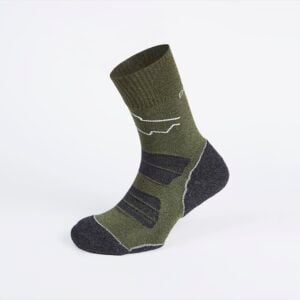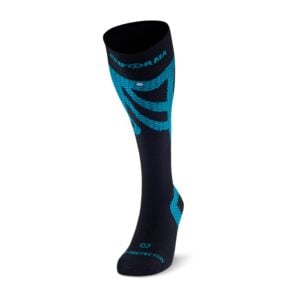Shin splints is a collective name for all kinds of disorders of the shins. The shinbone (tibia) is the large bone at the front of your lower leg. Shin splints injuries are mainly caused by overloading the shins, through running and other sporting activities. The most commonly occurring injury is an inflammation of the bone membrane of the shin bone. Shin splints are therefore also referred to as periosteum inflammation, jumping shins or medial tibial stress syndrome. It can be caused by poor footwear and not wearing compression socks during training.

What are Shin Splints?
Do you suffer from sore shins during or after your run? Then there is a good chance that you are suffering from shin splints. Shin splints is a collective name for several complaints and injuries that occur to the shin. Nowadays, this term is often replaced by the term medial tibial stress syndrome (MTSS). It is a complaint of pain in the lower part of the inner side of your shin bone. These complaints are common among runners, soldiers and in jump-related sports such as high jumping. Shin splints is a nagging pain that spreads over the lower leg. The pain occurs on exertion and, the longer the complaint exists, does not diminish at rest.
Shin splints are caused by overloading or by wearing poor quality shoes and socks. Bad shoes can be shoes that do not fit your foot or are walked on for too long. Bad socks are socks that do not support your foot, such as compression socks.
How do Shin Splints Happen?
Shin splints are always caused as a result of overburdening. The injury is caused by excessive traction forces from the deep calf muscles at the attachment to the shin bone. The deep calf muscles cannot absorb the load properly, which means that the foot cannot be kept stable and sinks inwards. As a result, the fibula and the tibia can be pushed too far apart, putting pressure on the tibial membrane.
The shinbone is a fragile bone which can easily become overloaded. Runners with a poor running technique, the wrong socks and footwear or who train too fast risk shin splints if they do not give their shin bone enough rest. Shin splints are not only common among runners; skaters, cyclists and soldiers also need to watch out for this injury.
What are the Symptoms of Shin Splints?
The symptoms of shin splints are very painful and they keep you from intensive sport and walking. The pain is mainly felt on the inside of the shin bone, just above the ankle. In the early stages of the injury, the pain is only felt under load, but as time goes on, the pain will also be felt at rest. The feet may also feel weaker. Swelling and redness may also occur around the shins. In addition to this pain, the following symptoms may also indicate shin splints:
– Pain on both sides of the shin bone
– nagging pain in the front part of the lower leg
– Pain on and along the inner part of the lower leg
On average, recovery from shin splints takes more than two months. Muscle and tendon disorders are generally slow to heal. If no measures are taken after the injury, such as the use of compression socks, good footwear and a change in training method, the pain will return.
How to Treat Shin Splints?
To heal shin splints, rest is the most important factor. It is best to do this when the symptoms have just started. This is to prevent them from getting worse. If you have the symptoms for a longer period of time, it is advisable to seek advice from a physiotherapist. He or she can advise you on:
– Warming up exercises
– Wearing soles
– Wearing the right shoes that are suitable for your type of foot
– Wearing compression socks
If the symptoms still persist, specific treatments are used. Think of ultrasound, shockwave therapy and dry needling. Wear Enforma Socks to prevent shin splints



Shin splints are a very annoying problem among runners and other athletes. In many cases, shin injuries can be prevented by wearing the right socks and shoes. Enforma Socks’ compression socks offer the right support during training. Compression socks exert a slight pressure on the legs and calves. Thanks to this pressure, your leg muscles will get a better blood circulation during your run. Better blood circulation means more oxygen in the muscles and quicker elimination of waste products. In addition, the socks have a shock-absorbing effect which drastically reduces muscle damage to the legs. This ensures that shin infections are prevented.
Curious about our range of compression socks? You can find them here.


